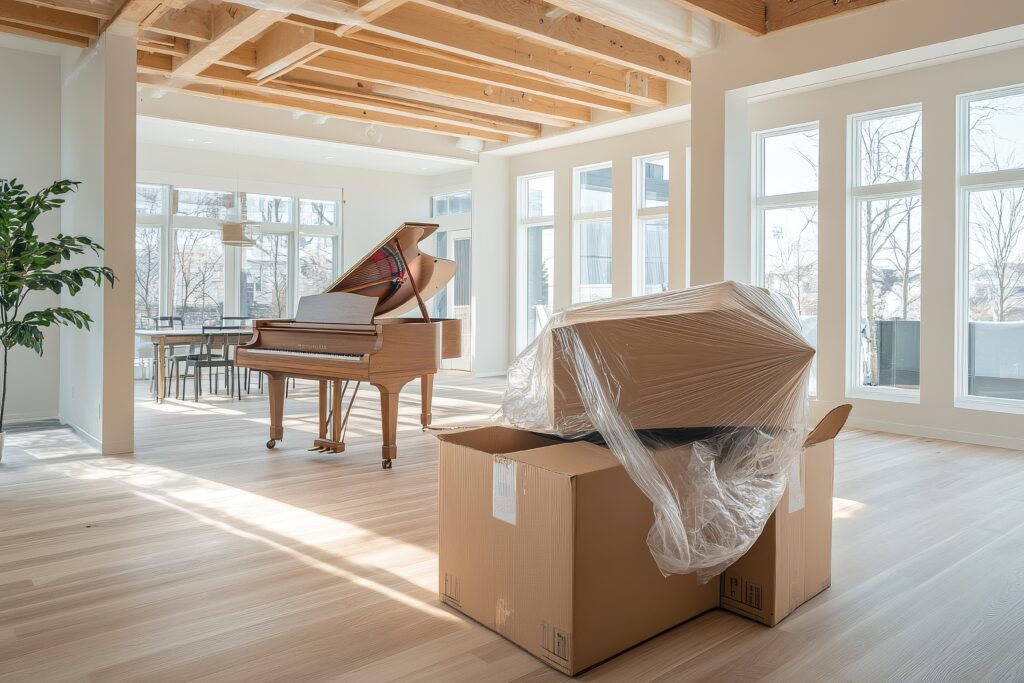
Moving a piano is a complex task that requires specialized techniques and equipment. Unlike standard furniture, pianos are heavy, delicate, and sensitive to environmental changes. Improper handling can lead to structural damage, tuning issues, or even serious injuries. While it may be tempting to move a piano without professional assistance, doing so can be risky and costly. Whether relocating across town or within the same home, hiring expert piano moving Denver services ensures safe and damage-free transport. This article explores the key factors that make piano moving different from other types of furniture relocation.
Weight and Size Considerations – Pianos Can Weigh Anywhere from 300 to 1,200+ lbs.
1. Sheer Weight and Bulkiness
Unlike standard furniture, pianos are among the heaviest household items, with weights ranging from 300 pounds for small uprights to over 1,200 pounds for concert grands. This significant weight makes them extremely difficult to lift and maneuver, especially through tight doorways, narrow hallways, and staircases. Moving a piano without the right equipment and techniques can result in serious damage to the instrument and surrounding property.
2. Size Variations Add to the Challenge
Pianos come in various sizes, from compact spinets to full-size grand pianos that can be nearly 9 feet long. Their shape and bulk make it difficult to grip and balance them properly, unlike rectangular furniture which is easier to manage. Navigating doorways, corners, or staircases with a large piano requires careful planning and coordination.
3. Specialized Equipment Is Necessary
Due to their weight and size, moving a piano requires specialized tools such as heavy-duty straps, furniture dollies, and custom padding. Without these, even a slight miscalculation in handling can lead to costly repairs. Professional movers use custom-built piano boards and ramps to ensure a smooth and secure move.
Delicate Components – Strings, Hammers, and Soundboards Are Fragile and Expensive to Repair
1. Sensitive Internal Mechanisms
Pianos are intricate instruments with thousands of delicate components. The strings, hammers, and soundboard work together to produce rich, resonant tones, but even minor damage can affect the sound quality. A single mishandled movement can cause internal parts to shift or break, requiring expensive repairs or complete replacements.
2. External Damage Can Ruin the Finish
The polished wood exterior of a piano is also highly vulnerable to scratches, dents, and chips. Unlike a sturdy wooden table, a piano’s finish can be easily marred by bumps against walls, floors, or other furniture during a move. Protecting the exterior with thick moving blankets and careful handling is essential to preserving its aesthetic appeal. To be better prepared for your piano moving day, read “How To Prepare Your Piano For Moving Day: Piano Movers Tips.”
3. Precision in Transport Is Essential
Unlike standard furniture, which can withstand rough handling, pianos must be transported with absolute precision. Tilting or dropping a piano incorrectly can damage the internal mechanics and knock it out of tune. Professional piano movers understand how to keep the instrument level and stable throughout the moving process.
Balance and Stability Issues – Pianos Have an Uneven Weight Distribution, Making Them Difficult to Maneuver
1. Uneven Weight Distribution
One of the biggest challenges of moving a piano is its uneven weight. Grand pianos, for example, have most of their weight concentrated on one side, making them difficult to balance. Even upright pianos, which appear more evenly shaped, have much of their weight concentrated toward the back. This imbalance makes it hard to control the movement, increasing the risk of tipping over.
2. Navigating Tight Spaces
Unlike furniture with a symmetrical shape, pianos require careful planning when moving through doorways, hallways, and stairwells. Tilting the instrument at the wrong angle can shift its weight unexpectedly, leading to instability or even toppling. This is especially dangerous in multi-story homes or apartment buildings.
3. Securing the Piano Properly
Professional movers use techniques such as strapping the piano securely to a dolly or using a skid board to distribute weight evenly. Without proper stabilization, an unbalanced piano can shift during transport, putting strain on its legs and internal components.
Climate Sensitivity – Wood and Tuning Are Affected by Temperature and Humidity Changes
1. Wood Expansion and Contraction
Pianos are primarily made of wood, which expands and contracts based on temperature and humidity levels. Exposure to extreme heat, cold, or moisture can cause the wood to warp, affecting the piano’s sound quality and longevity. A move that involves drastic climate changes, such as relocating from a humid to a dry environment, requires extra precautions to prevent damage.
2. Impact on Tuning Stability
Even small shifts in temperature and humidity can knock a piano out of tune. Moving a piano between locations with different climate conditions often leads to detuning, requiring professional adjustments after the move. Ideally, pianos should be acclimated to their new environment before tuning.
3. Protecting the Piano from Environmental Changes
Professional movers take steps to minimize climate-related damage by using protective covers and transporting the piano in climate-controlled vehicles. If the piano will be in storage, it should be kept in a climate-controlled facility to prevent wood warping and moisture buildup.
Risk of Injury – Without Proper Lifting Techniques, Movers Risk Back Strain and Other Injuries
1. Heavy Lifting Strain
Moving a piano requires lifting and carrying substantial weight, putting immense strain on the back, shoulders, and legs. Without proper technique, movers can suffer serious injuries such as muscle sprains, herniated discs, or even broken bones. Unlike moving a couch or table, a piano’s weight makes it far more dangerous to lift improperly.
2. Potential for Accidents
A piano that is not handled correctly can become a safety hazard. If it tips over or slips out of grip, it can cause severe injury to the movers or damage to floors and walls. This risk is especially high when navigating stairs or tight spaces.
3. The Importance of Professional Movers
Professional piano movers are trained to use specialized lifting techniques and equipment to minimize the risk of injury. They work in coordinated teams to ensure the piano is lifted and transported safely, preventing accidents that can occur with inexperienced handling.
Conclusion
Moving a piano is far more complex than relocating standard furniture. The weight, size, delicate components, and climate sensitivity all contribute to the challenges of safe transport. Without proper precautions, both the piano and the movers themselves are at risk of harm. By hiring piano moving professionals, piano owners can ensure their instrument is relocated safely, avoiding costly damage or injury. Investing in expert movers is the best way to protect both the piano and those involved in the move.
Moving a piano is no small task, and the risks of damage or injury are high without the right expertise. Let the professionals at Mountain Piano Moving Company handle the job with care and precision. Our team is trained to transport pianos safely, ensuring their structure and sound quality remain intact. Don’t leave your valuable instrument in inexperienced hands—trust the experts for a seamless move. For a worry-free piano relocation, contact our experts today.

